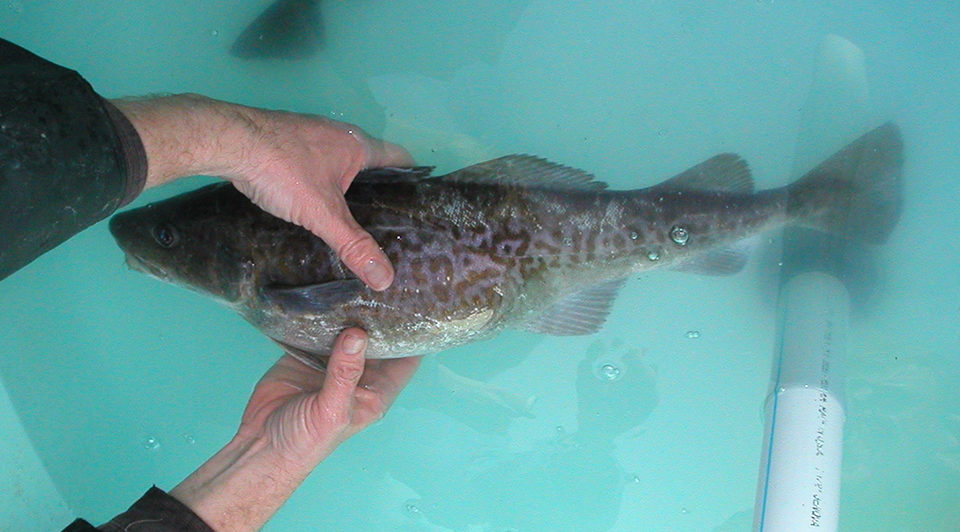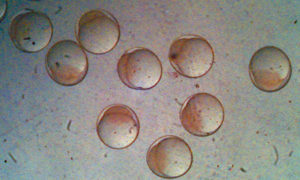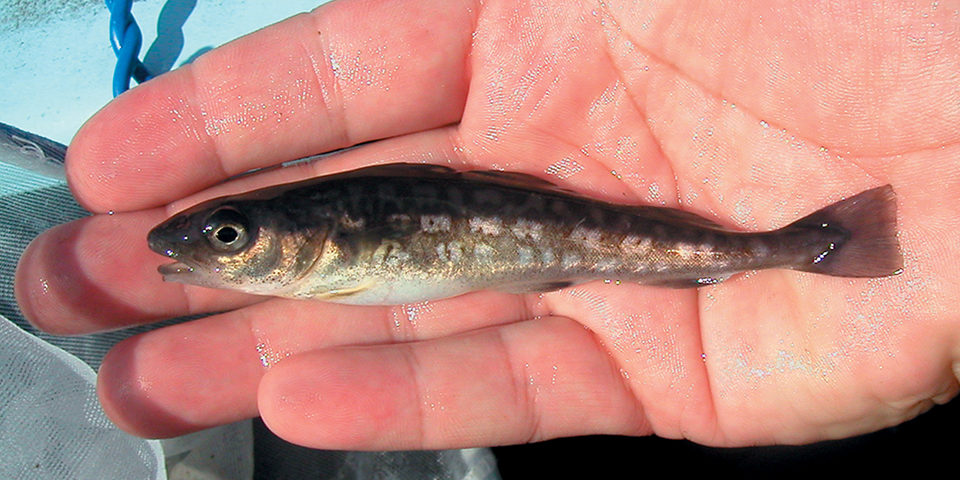Broodstock maintenance, spawning and larval and juvenile growth methods under development

Commercial aquaculture of the fast-growing Atlantic cod (Gadus morhua) is under way in Norway, Scotland, Canada and the United States. Years of larviculture research have resulted in efficient, intensive production of juveniles for grow-out. Mass rearing of juveniles was achieved in the early 1980s, opening possibilities for aquaculture and enhancement.
Enhancement experiments for the Atlantic cod capture fishery using released larvae, juveniles, and adults have been ongoing in Canada and Europe. The benefits and drawbacks of these enhancement efforts remain unclear, though the studies have generated valuable information on cod growth and migration.
Pacific cod
But wait, there is another cod out there – Pacific cod (Gadus macrocephalus). With a story similar to that for cod in the North Atlantic, research in Japan and Korea over the past decade or two has resulted in commercial production in Japan and strong interest in Korea.
Pacific and Atlantic cod share similar ecology, physiology and biology. Originally, Pacific cod were thought to be a subspecies of Atlantic cod, but now are classified as a separate species.
Pacific cod are found in cooler regions of the Pacific from Japan to the Bering Sea to California, USA. They are demersal and feed on shrimp and small fish near the ocean bottom. Throughout the year, cod migrate between feeding and spawning grounds, feeding in deep water and spawning in shallow, cold water during the winter. Unlike Atlantic cod, Pacific cod broadcast their eggs over sand and cobble, to which the eggs adhere until hatching. After hatching, the larvae migrate upward and drift around until they reach about 35 mm in length and begin a demersal life.
Population declines
Until about 1980, Pacific cod were the second most common species caught recreationally in the marine waters of Washington, USA. Cod were so abundant in Puget Sound that salmon anglers sometimes considered them a nuisance. However, a rapid decline that began in the mid-1980s made cod rare even at historic breeding grounds during peak spawning times. South Puget Sound cod may be near extinction, and North Puget Sound populations are severely depleted.
Reasons for the decline are unclear but may include overfishing – there was a short-lived commercial fishery, habitat loss, and rising water temperatures. Because of spawning ground loss and two decades of dramatic population decline, a petition to list Pacific cod as an endangered species was submitted. However, protection was not granted because it could not be shown the cod spawning in Puget Sound were different from the more abundant northern stocks.
Cod aquaculture
Cultured Pacific cod could compete with Atlantic cod, as flesh quality is similar in the two species. Because of its ecological significance, importance as a sports fish, and low abundance in Puget Sound and other isolated seas, Pacific cod are a good candidate for culture-based stock rebuilding.
Research with Pacific cod at the Resource Enhancement and Utilization Technologies Division of the Northwest Fisheries Science Center in Seattle, Washington, USA, is evaluating their potential for aquaculture by developing methods for broodstock maintenance, spawning, and larval and juvenile growth. Eventual rebuilding of the Puget Sound spawning stock is another goal.
Broodstock acquisition, maintenance

In the research, broodstock were targeted as they entered near-shore areas to spawn. Catching fish at shallow depths reduced stress associated with swim bladder overinflation. After several days of trawling and angling, only 14 adults were obtained from spawning areas in central Puget Sound that once supported a commercial fishery. They were then transferred to a hatchery facility.
Although a small group, the fish provide enough eggs for research. They are adapting well to hatchery conditions. The cod are held in circular fiberglass tanks of 6-meter diameter that are supplied with recirculated chilled water to maintain temperatures of 7 to 9 degrees-C.
After entering the hatchery, cod are fed herrings for a few weeks and then switched as soon as possible to a prepared feed. Incorporating approximately 5 percent krill into the diet increases the palatability of the prepared feed and greatly reduces the weaning period.
Spawning
Unlike Atlantic cod, Pacific cod are single-batch spawners. Depending on size and age, females produce anywhere from 200,000 to 5 million eggs. During the spawning season (February to March in Puget Sound), the cod are examined every few days for signs of maturity. The mature fish are strip-spawned or tank-spawned.

Eggs and larvae
The fertilized eggs are about 1 mm in diameter, weakly adhesive, and negatively buoyant. Pacific cod larvae are approximately 3 to 4 mm at hatch. The yolk-sac period lasts another 10 days at 10 degrees-C. At first feeding, the cod are fed a combination of rotifers enriched with fatty acid supplements and wild-captured zooplankton. As the fish grow, they are switched to enriched artemia and then prepared feed. Metamorphosis occurs at about 25 mm.
In addition to the standard live feed protocol for larval culture, initial experience with larvae showed them to be hardy and aggressive feeders on microparticulate diets. A group of about 100 larvae approximately 6 days old were also fed a dry microparticulate diet formulated and manufactured by the authors’ group.
The larvae ate the dry diet to apparent satiation and continued to feed well for five more days before the experiment was terminated. In six months, the larvae grew to the fingerling size ready for tagging and release or growing out for market. Future trials will investigate rearing larvae with minimal or no live feeds.
(Editor’s Note: This article was originally published in the February 2004 print edition of the Global Aquaculture Advocate.)
Now that you've finished reading the article ...
… we hope you’ll consider supporting our mission to document the evolution of the global aquaculture industry and share our vast network of contributors’ expansive knowledge every week.
By becoming a Global Seafood Alliance member, you’re ensuring that all of the pre-competitive work we do through member benefits, resources and events can continue. Individual membership costs just $50 a year. GSA individual and corporate members receive complimentary access to a series of GOAL virtual events beginning in April. Join now.
Not a GSA member? Join us.
Authors
-
Matthew Cook
Northwest Fisheries Science Center
Resource Enhancement and Utilization Technologies Division
2725 Montlake Boulevard E
Seattle, Washington 98012 USA -
Kenneth Massee
Northwest Fisheries Science Center
Resource Enhancement and Utilization Technologies Division
2725 Montlake Boulevard E
Seattle, Washington 98012 USA -
Michael Rust, Ph.D.
Northwest Fisheries Science Center
Resource Enhancement and Utilization Technologies Division
2725 Montlake Boulevard E
Seattle, Washington 98012 USA
Tagged With
Related Posts

Health & Welfare
Atlantic cod genomics and broodstock development project
The Atlantic Cod Genomics and Broodstock Development Project has expanded the gene-related resources for the species in Canada.

Health & Welfare
New molecular techniques detect nodaviruses in Atlantic cod hatcheries
The nodaviruses that can infect the nervous systems of Atlantic cod threaten further expansion of the burgeoning cod-farming industry.

Health & Welfare
Screening probiotic bacteria for Atlantic cod larvae
The addition of probiotic bacteria to marine larvae can reduce pathogenic bacteria and subsequent infection by establishing a protective flora on the mucosal surfaces of the larvae.

Health & Welfare
Photoperiod regulation inhibits spawning, promotes growth in Atlantic cod
Research has shown that an extended photoperiod for Atlantic cod females leads to reduced gonadal growth, faster body growth and shorter grow-out production periods.


